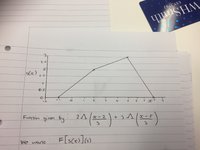LancsPhys14
New member
- Joined
- Feb 16, 2020
- Messages
- 4
We have a graph as shown in the picture. We want to find the Fourier transform of this function.
This function is given by: 2Tri((x-2)/3)+3Tri((x-5)/3) where Tri(x) is a traingle function
We know:
F[Tri(x/p)]=psinc^2(ps)
F[g(x-a)]=e^(-i2pias)G(s)
Does this mean F[Tri((x/p)-a)]=e^(-i2pias)psinc^2(ps)?
If anyone could provide a method or expression for how to find the Fourier transform of a shifted and scaled triangular function, I would appreciate it. Alternatively, if the function found for the graph is incorrect I would appreciate knowing.
This function is given by: 2Tri((x-2)/3)+3Tri((x-5)/3) where Tri(x) is a traingle function
We know:
F[Tri(x/p)]=psinc^2(ps)
F[g(x-a)]=e^(-i2pias)G(s)
Does this mean F[Tri((x/p)-a)]=e^(-i2pias)psinc^2(ps)?
If anyone could provide a method or expression for how to find the Fourier transform of a shifted and scaled triangular function, I would appreciate it. Alternatively, if the function found for the graph is incorrect I would appreciate knowing.

